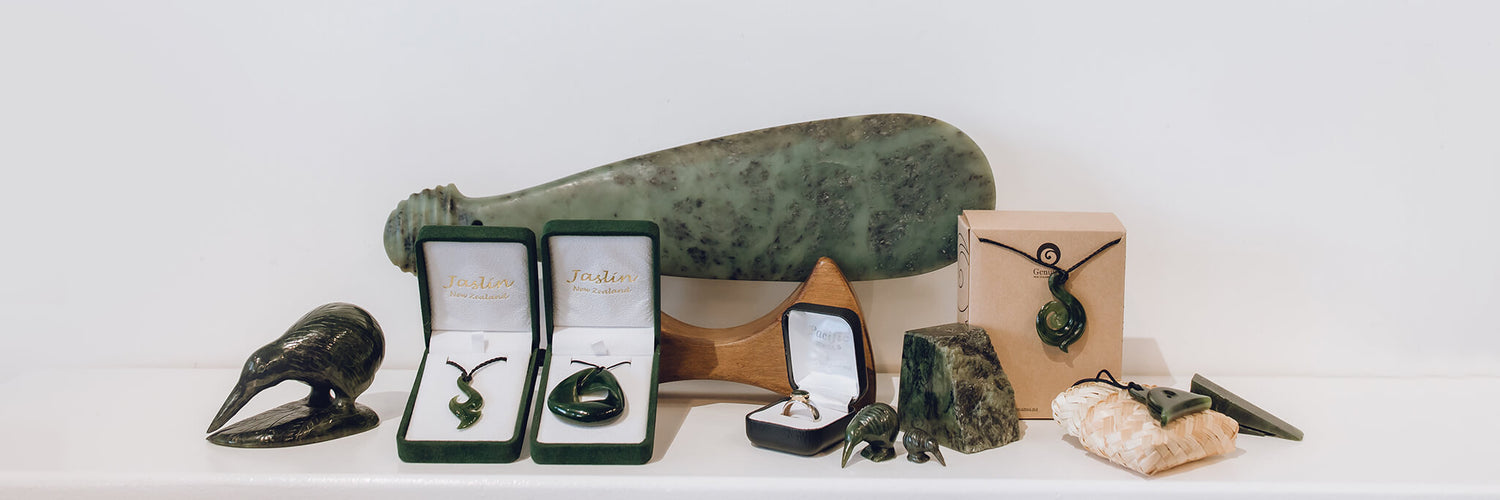About Jade
There are two types of Jade; Jadeite and Nephrite. Jadeite is a silicate of sodium and aluminium and is found in an area of Northern China. Nephrite is a silicate of calcium and magnesium and is found in New Zealand.
Greenstone - A term particular to New Zealand to describe nephrite, with sometimes the inclusion of bowenite. It was called pounamu by the Maori people. The first European explorers who came to New Zealand saw the Maori wearing Jade ornaments and called it Greenstone not realising that it was a type of Jade. The name has stuck ever since.
Pounamu plays a very important role in Maori culture. It is considered a taonga (treasure). Tools, ornaments and weapons were made from it; in particular adzes, mere (short clubs) and hei-tiki (neck pendants). These were believed to have their own mana (status), were handed down as valued heirlooms and were often given as gifts to seal important agreements.
Pounamu is generally found in rivers as nondescript boulders and stones which are difficult to identify without cutting them open.
The main varieties are kawakawa, kahurangi, īnanga and tangiwai. The first three are nephrite jade, while tangiwai is a form of bowenite.
Kawakawa is the most common variety of pounamu. It comes in many shades – from strong rich green to dark green – and often has small dark flecks, called inclusions, which add to its character.
Kawakawa pounamu is named after the common native kawakawa tree (Macropiper excelsum). Its colour is likened to the leaves of the tree.
Variations of kawakawa include the olive-green raukaraka pounamu and totoweka pounamu, which has reddish spots and streaks.
The inanga variety of pounamu takes its name from inanga – a native freshwater fish (Galaxias maculatus). The young of this species are commonly known as whitebait. Inanga pounamu resembles the pale colour and transparency of the mata (young whitebait).
Inanga pounamu is described as parly-white or grey-green, and varies from translucent to opaque. It can change colour over time, developing a light-olive tint as it ages and oxidises.
Maori sometimes heat-treated other varieties of pounamu at low temperatures to give them inanga’s silvery characteristics.
Inanga is found in most of New Zealand’s seven pounamu source areas, and is especially prized by southern Maori.
Kahurangi is the rarest variety of pounamu. It is highly translucent and often comes in vivid shades of green.
Kahurangi is named after the clearness of the sky. Small, feather-like markings in the stone can give a cloud effect – although in order to be classed as kahurangi, this effect must not reduce the stone’s clarity. The word kahurangi also indicates nobility and refers to precious jewels.
Kahurangi pounamu is particularly esteemed by Maori. In the past, it was the preferred variety of stone for the blades of toki poutangata (ceremonial adzes) owned by rangatira (chiefs).
Tangiwai is clear like glass, and ranges from olive-green to bluish-green in colour.
Tangiwai is the most ancient form of pounamu. It is bowenite rock, which is different in composition to the more common nephrite. Most tangiwai is sourced from two isolated areas at Milford Sound.
Tangiwai takes its name from the tears that come from great sorrow. Tangi means "to cry" and wai means "water", or "tears". Koko-tangiwai, the longer name for this stone, refers to a deep sorrow that is never completely healed.

